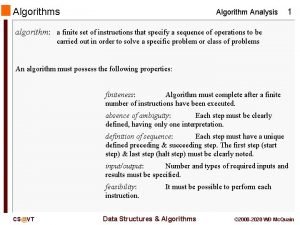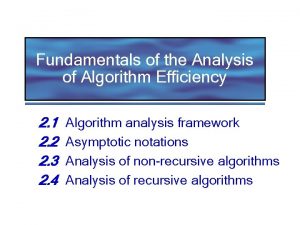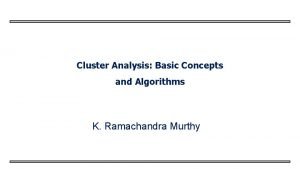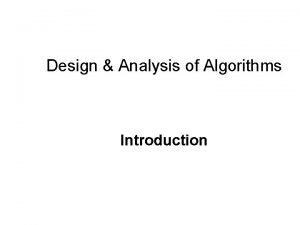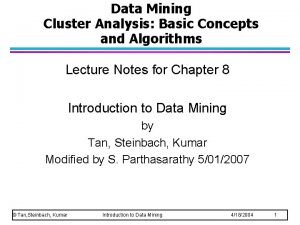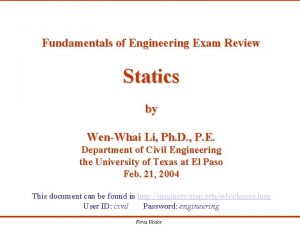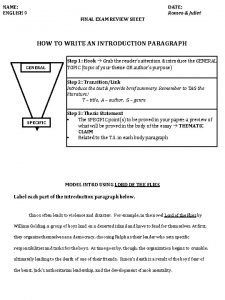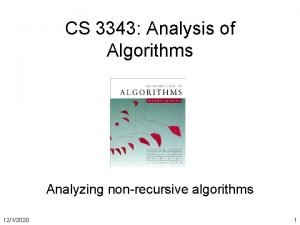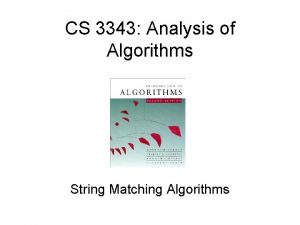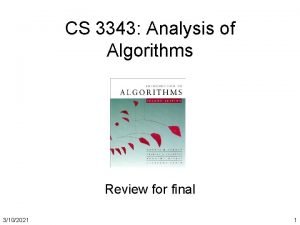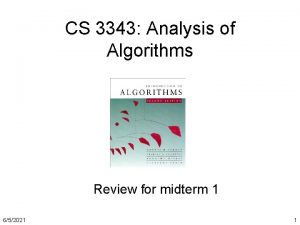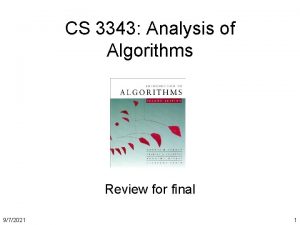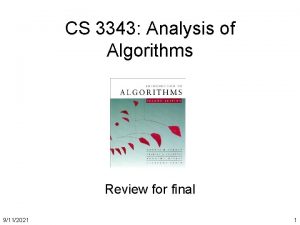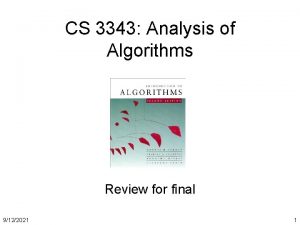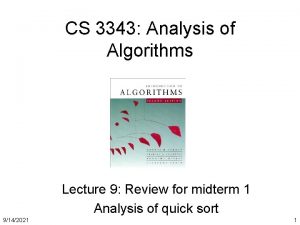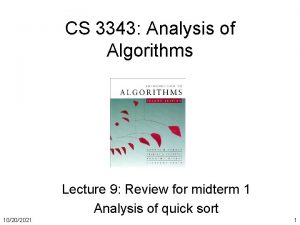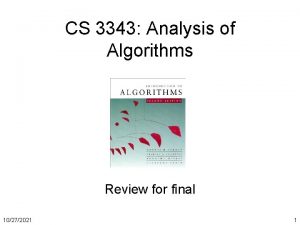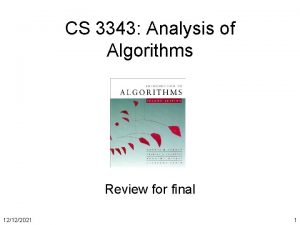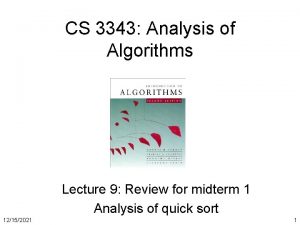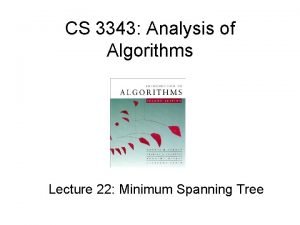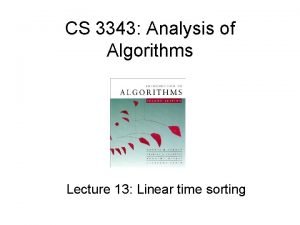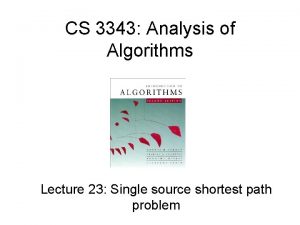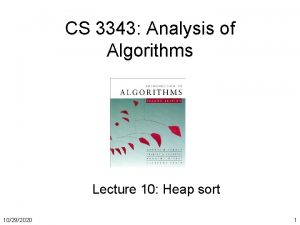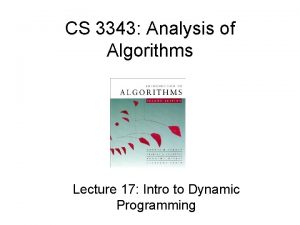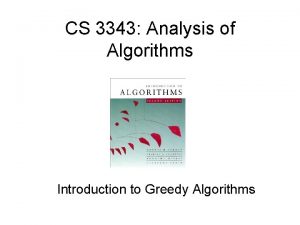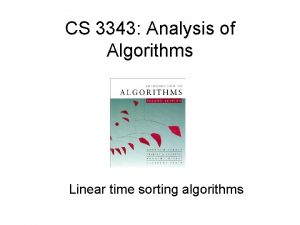CS 3343 Analysis of Algorithms Review for Exam







![Partition Code Partition(A, p, r) x = A[p]; // pivot is the first element Partition Code Partition(A, p, r) x = A[p]; // pivot is the first element](https://slidetodoc.com/presentation_image_h2/3e3b4f05f458276799649ef884661050/image-8.jpg)
































![Heapsort(A) { Build. Heap(A); for (i = length(A) downto 2) { Swap(A[1], A[i]); heap_size(A) Heapsort(A) { Build. Heap(A); for (i = length(A) downto 2) { Swap(A[1], A[i]); heap_size(A)](https://slidetodoc.com/presentation_image_h2/3e3b4f05f458276799649ef884661050/image-41.jpg)










![Implementing Priority Queues Heap. Maximum(A) { return A[1]; } Implementing Priority Queues Heap. Maximum(A) { return A[1]; }](https://slidetodoc.com/presentation_image_h2/3e3b4f05f458276799649ef884661050/image-52.jpg)
![Implementing Priority Queues Heap. Extract. Max(A) { if (heap_size[A] < 1) { error; } Implementing Priority Queues Heap. Extract. Max(A) { if (heap_size[A] < 1) { error; }](https://slidetodoc.com/presentation_image_h2/3e3b4f05f458276799649ef884661050/image-53.jpg)



![Implementing Priority Queues Heap. Change. Key(A, i, key){ if (key ≤ A[i]){ // decrease Implementing Priority Queues Heap. Change. Key(A, i, key){ if (key ≤ A[i]){ // decrease](https://slidetodoc.com/presentation_image_h2/3e3b4f05f458276799649ef884661050/image-57.jpg)



![Implementing Priority Queues Heap. Insert(A, key) { heap_size[A] ++; i = heap_size[A]; A[i] = Implementing Priority Queues Heap. Insert(A, key) { heap_size[A] ++; i = heap_size[A]; A[i] =](https://slidetodoc.com/presentation_image_h2/3e3b4f05f458276799649ef884661050/image-61.jpg)





![Counting sort 1. for i 1 to k Initialize do C[i] 0 Count 2. Counting sort 1. for i 1 to k Initialize do C[i] 0 Count 2.](https://slidetodoc.com/presentation_image_h2/3e3b4f05f458276799649ef884661050/image-67.jpg)


![Analysis (k) (n) (n + k) 1. for i 1 to k do C[i] Analysis (k) (n) (n + k) 1. for i 1 to k do C[i]](https://slidetodoc.com/presentation_image_h2/3e3b4f05f458276799649ef884661050/image-70.jpg)

















![Longest Common Subsequence • Given two sequences x[1. . m] and y[1. . n], Longest Common Subsequence • Given two sequences x[1. . m] and y[1. . n],](https://slidetodoc.com/presentation_image_h2/3e3b4f05f458276799649ef884661050/image-88.jpg)

![Finding length of LCS m x n y • Let c[i, j] be the Finding length of LCS m x n y • Let c[i, j] be the](https://slidetodoc.com/presentation_image_h2/3e3b4f05f458276799649ef884661050/image-90.jpg)

![LCS Example (0) j i 0 X[i] 1 A 2 B 3 C 4 LCS Example (0) j i 0 X[i] 1 A 2 B 3 C 4](https://slidetodoc.com/presentation_image_h2/3e3b4f05f458276799649ef884661050/image-92.jpg)
![LCS Example (1) j i ABCB BDCAB 5 0 Y[j] 1 B 2 D LCS Example (1) j i ABCB BDCAB 5 0 Y[j] 1 B 2 D](https://slidetodoc.com/presentation_image_h2/3e3b4f05f458276799649ef884661050/image-93.jpg)
![LCS Example (2) j i ABCB BDCAB 5 0 Y[j] 1 B 2 D LCS Example (2) j i ABCB BDCAB 5 0 Y[j] 1 B 2 D](https://slidetodoc.com/presentation_image_h2/3e3b4f05f458276799649ef884661050/image-94.jpg)
![LCS Example (3) j i ABCB BDCAB 5 0 Y[j] 1 B 2 D LCS Example (3) j i ABCB BDCAB 5 0 Y[j] 1 B 2 D](https://slidetodoc.com/presentation_image_h2/3e3b4f05f458276799649ef884661050/image-95.jpg)
![LCS Example (4) j i ABCB BDCAB 5 0 Y[j] 1 B 2 D LCS Example (4) j i ABCB BDCAB 5 0 Y[j] 1 B 2 D](https://slidetodoc.com/presentation_image_h2/3e3b4f05f458276799649ef884661050/image-96.jpg)
![LCS Example (5) j i ABCB BDCAB 5 0 Y[j] 1 B 2 D LCS Example (5) j i ABCB BDCAB 5 0 Y[j] 1 B 2 D](https://slidetodoc.com/presentation_image_h2/3e3b4f05f458276799649ef884661050/image-97.jpg)
![LCS Example (6) j i ABCB BDCAB 5 0 Y[j] 1 B 2 D LCS Example (6) j i ABCB BDCAB 5 0 Y[j] 1 B 2 D](https://slidetodoc.com/presentation_image_h2/3e3b4f05f458276799649ef884661050/image-98.jpg)
![LCS Example (7) j i ABCB BDCAB 5 0 Y[j] 1 B 2 D LCS Example (7) j i ABCB BDCAB 5 0 Y[j] 1 B 2 D](https://slidetodoc.com/presentation_image_h2/3e3b4f05f458276799649ef884661050/image-99.jpg)
![LCS Example (8) j i ABCB BDCAB 5 0 Y[j] 1 B 2 D LCS Example (8) j i ABCB BDCAB 5 0 Y[j] 1 B 2 D](https://slidetodoc.com/presentation_image_h2/3e3b4f05f458276799649ef884661050/image-100.jpg)
![LCS Example (9) j i ABCB BDCAB 5 0 Y[j] 1 B 2 D LCS Example (9) j i ABCB BDCAB 5 0 Y[j] 1 B 2 D](https://slidetodoc.com/presentation_image_h2/3e3b4f05f458276799649ef884661050/image-101.jpg)
![LCS Example (10) j i ABCB BDCAB 5 0 Y[j] 1 B 2 D LCS Example (10) j i ABCB BDCAB 5 0 Y[j] 1 B 2 D](https://slidetodoc.com/presentation_image_h2/3e3b4f05f458276799649ef884661050/image-102.jpg)
![LCS Example (11) j i ABCB BDCAB 5 0 Y[j] 1 B 2 D LCS Example (11) j i ABCB BDCAB 5 0 Y[j] 1 B 2 D](https://slidetodoc.com/presentation_image_h2/3e3b4f05f458276799649ef884661050/image-103.jpg)
![LCS Example (12) j i ABCB BDCAB 5 0 Y[j] 1 B 2 D LCS Example (12) j i ABCB BDCAB 5 0 Y[j] 1 B 2 D](https://slidetodoc.com/presentation_image_h2/3e3b4f05f458276799649ef884661050/image-104.jpg)
![LCS Example (13) j i ABCB BDCAB 5 0 Y[j] 1 B 2 D LCS Example (13) j i ABCB BDCAB 5 0 Y[j] 1 B 2 D](https://slidetodoc.com/presentation_image_h2/3e3b4f05f458276799649ef884661050/image-105.jpg)
![LCS Example (14) j i ABCB BDCAB 5 0 Y[j] 1 B 2 D LCS Example (14) j i ABCB BDCAB 5 0 Y[j] 1 B 2 D](https://slidetodoc.com/presentation_image_h2/3e3b4f05f458276799649ef884661050/image-106.jpg)


![Finding LCS j 0 Y[j] 1 B 2 D 3 C 4 A 5 Finding LCS j 0 Y[j] 1 B 2 D 3 C 4 A 5](https://slidetodoc.com/presentation_image_h2/3e3b4f05f458276799649ef884661050/image-109.jpg)
![Finding LCS (2) j 0 Y[j] 1 B 2 D 3 C 4 A Finding LCS (2) j 0 Y[j] 1 B 2 D 3 C 4 A](https://slidetodoc.com/presentation_image_h2/3e3b4f05f458276799649ef884661050/image-110.jpg)








![Recursive formulation • Let V[i, w] be the optimal total value when items 1, Recursive formulation • Let V[i, w] be the optimal total value when items 1,](https://slidetodoc.com/presentation_image_h2/3e3b4f05f458276799649ef884661050/image-119.jpg)




























- Slides: 147

CS 3343: Analysis of Algorithms Review for Exam 2

Exam 2 • Closed book exam • One cheat sheet allowed (limit to a single page of letter-size paper, double-sided) • Tuesday, Nov 17, class time + 5 minutes • Basic calculator (no graphing) is allowed but not necessary

Final grade calculation • Three components: HQP, Midterm, Final • HQ = HW + Quiz + Participation : (90% HW + 10% Quiz&Participation) : One lowest HW dropped • • Midterm = 40% midterm 1+ 60% midterm 2 Max for each component is 100. Sort three components (highest, middle, lowest) Final grade: – Case 1: HQP is not the highest 55% highest + 30% middle + 15% lowest – Case 2: HQP is highest 55% middle + 30% HQP + 15% lowest

Materials covered • • Quick Sort Heap sort, priority queue Linear time sorting algorithms Order statistics Dynamic programming Greedy algorithm Graph basics • Questions will be similar to homework / quizzes – Familiar with the algorithm procedure – Some analysis of time/space complexity – One or two problems on algorithm design

Quick. Sort • • Quicksort algorithm Randimized Quicksort algorithm Partition algorithm Quicksort/Randomized Quicksort time complexity analysis Back

Quick sort Quicksort an n-element array: 1. Divide: Partition the array into two subarrays around a pivot x such that elements in lower subarray £ x £ elements in upper subarray. £x x ≥x 2. Conquer: Recursively sort the two subarrays. 3. Combine: Trivial. Key: Linear-time partitioning subroutine.

Pseudocode for quicksort QUICKSORT(A, p, r) if p < r then q PARTITION(A, p, r) QUICKSORT(A, p, q– 1) QUICKSORT(A, q+1, r) Initial call: QUICKSORT(A, 1, n)
![Partition Code PartitionA p r x Ap pivot is the first element Partition Code Partition(A, p, r) x = A[p]; // pivot is the first element](https://slidetodoc.com/presentation_image_h2/3e3b4f05f458276799649ef884661050/image-8.jpg)
Partition Code Partition(A, p, r) x = A[p]; // pivot is the first element i = p; j = r + 1; while (TRUE) { repeat i++; until A[i] > x | i >= j; repeat j--; until A[j] < x | j <= i; if (i < j) Swap (A[i], A[j]); else break; } swap (A[p], A[j]); return j;

p x=6 6 r 10 5 8 13 3 2 11 i 6 j 10 5 8 13 3 i 6 2 5 8 13 3 2 5 5 p 3 2 10 11 swap 5 3 10 11 scan 10 11 swap 10 11 scan j 3 13 i 6 scan j i 6 11 j i Partition example 2 8 j 3 13 j i q 6 13 8 r 8 10 11 final swap

6 10 5 8 11 3 2 13 Quick sort example 3 2 5 6 11 8 10 13 2 3 5 6 10 8 11 13 2 3 5 6 8 10 11 13

Quicksort Runtimes • Best case runtime Tbest(n) O(n log n) • Worst case runtime Tworst(n) O(n 2) • Average case runtime Tavg(n) O(n log n) • Expected runtime of randomized quicksort is O(n log n)

Randomized Partition • Randomly choose an element as pivot – Every time need to do a partition, throw a die to decide which element to use as the pivot – Each element has 1/n probability to be selected Rand-Partition(A, p, r){ d = random(); // draw a random number between 0 and 1 index = p + floor((r-p+1) * d); // p<=index<=q swap(A[p], A[index]); Partition(A, p, r); // now use A[p] as pivot }

Running time of randomized quicksort T(0) + T(n– 1) + dn if 0 : n– 1 split, T(1) + T(n– 2) + dn if 1 : n– 2 split, T(n) = M T(n– 1) + T(0) + dn if n– 1 : 0 split, • The expected running time is an average of all cases Expectation

• Fact: • Need to Prove: T(n) ≤ c n log (n) • Assumption: T(k) ≤ ck log (k) for 0 ≤ k ≤ n-1 • Prove by induction If c ≥ 4

Heaps • Heap definition • Heapify • Buildheap – Procedure and running time (!) • Heapsort – Comparison with other sorting algorithms in terms of running time, stability, and in-place. • Priority Queue operations Back

Heaps • A heap can be seen as a complete binary tree: Perfect binary tree 16 14 10 8 2 7 4 9 3 1 16 14 10 8 7 9 3 2 4 1

Referencing Heap Elements • So… Parent(i) {return i/2 ; } Left(i) {return 2*i; } right(i) {return 2*i + 1; }

Heap Operations: Heapify() Heapify(A, i) { // precondition: subtrees rooted at l and r are heaps l = Left(i); r = Right(i); if (l <= heap_size(A) && A[l] > A[i]) largest = l; Among A[l], A[i], A[r], else which one is largest? largest = i; if (r <= heap_size(A) && A[r] > A[largest]) largest = r; if (largest != i) { Swap(A, i, largest); If violation, fix it. Heapify(A, largest); } } // postcondition: subtree rooted at i is a heap

Heapify() Example 16 4 10 14 2 7 8 9 3 1 A = 16 4 10 14 7 9 3 2 8 1

Heapify() Example 16 4 10 14 2 7 8 9 3 1 A = 16 4 10 14 7 9 3 2 8 1

Heapify() Example 16 4 10 14 2 7 8 9 3 1 A = 16 4 10 14 7 9 3 2 8 1

Heapify() Example 16 14 10 4 2 7 8 9 3 1 A = 16 14 10 4 7 9 3 2 8 1

Heapify() Example 16 14 10 4 2 7 8 9 3 1 A = 16 14 10 4 7 9 3 2 8 1

Heapify() Example 16 14 10 8 2 7 4 9 3 1 A = 16 14 10 8 7 9 3 2 4 1

Heapify() Example 16 14 10 8 2 7 4 9 3 1 A = 16 14 10 8 7 9 3 2 4 1

Build. Heap() // given an unsorted array A, make A a heap Build. Heap(A) { heap_size(A) = length(A); for (i = length[A]/2 downto 1) Heapify(A, i); }

Build. Heap() Example • Work through example A = {4, 1, 3, 2, 16, 9, 10, 14, 8, 7} 4 1 3 2 14 16 8 A= 9 10 7 4 1 3 2 16 9 10 14 8 7

4 1 3 2 14 16 8 A= 9 10 7 4 1 3 2 16 9 10 14 8 7

4 1 3 2 14 16 8 A= 9 10 7 4 1 3 2 16 9 10 14 8 7

4 1 3 14 2 16 8 A= 9 10 7 4 1 3 14 16 9 10 2 8 7

4 1 3 14 2 16 8 A= 9 10 7 4 1 3 14 16 9 10 2 8 7

4 1 10 14 2 16 8 A= 9 3 7 4 1 10 14 16 9 3 2 8 7

4 1 10 14 2 16 8 A= 9 3 7 4 1 10 14 16 9 3 2 8 7

4 16 10 14 2 1 8 A= 9 3 7 4 16 10 14 1 9 3 2 8 7

4 16 10 14 2 7 8 A= 9 3 1 4 16 10 14 7 9 3 2 8 1

4 16 10 14 2 7 8 A= 9 3 1 4 16 10 14 7 9 3 2 8 1

16 4 10 14 2 7 8 9 3 1 A = 16 4 10 14 7 9 3 2 8 1

16 14 10 4 2 7 8 9 3 1 A = 16 14 10 4 7 9 3 2 8 1

16 14 10 8 2 7 4 9 3 1 A = 16 14 10 8 7 9 3 2 4 1

Analyzing Build. Heap(): Tight • To Heapify() a subtree takes O(h) time where h is the height of the subtree – h = O(lg m), m = # nodes in subtree – The height of most subtrees is small • Fact: an n-element heap has at most n/2 h+1 nodes of height h • CLR 6. 3 uses this fact to prove that Build. Heap() takes O(n) time
![HeapsortA Build HeapA for i lengthA downto 2 SwapA1 Ai heapsizeA Heapsort(A) { Build. Heap(A); for (i = length(A) downto 2) { Swap(A[1], A[i]); heap_size(A)](https://slidetodoc.com/presentation_image_h2/3e3b4f05f458276799649ef884661050/image-41.jpg)
Heapsort(A) { Build. Heap(A); for (i = length(A) downto 2) { Swap(A[1], A[i]); heap_size(A) -= 1; Heapify(A, 1); } }

Heapsort Example • Work through example A = {4, 1, 3, 2, 16, 9, 10, 14, 8, 7} 4 1 3 2 14 16 8 A= 9 10 7 4 1 3 2 16 9 10 14 8 7

Heapsort Example • First: build a heap 16 14 10 8 2 7 4 9 3 1 A = 16 14 10 8 7 9 3 2 4 1

Heapsort Example • Swap last and first 1 14 10 8 2 7 4 A= 9 3 16 1 14 10 8 7 9 3 2 4 16

Heapsort Example • Last element sorted 1 14 10 8 2 7 4 A= 9 3 16 1 14 10 8 7 9 3 2 4 16

Heapsort Example • Restore heap on remaining unsorted elements 14 8 10 4 2 7 1 9 16 A = 14 8 10 4 3 Heapify 7 9 3 2 1 16

Heapsort Example • Repeat: swap new last and first 1 8 10 4 2 7 14 A= 9 3 16 1 8 10 4 7 9 3 2 14 16

Heapsort Example • Restore heap 10 8 9 4 2 7 14 1 3 16 A = 10 8 9 4 7 1 3 2 14 16

Heapsort Example • Repeat 9 8 3 4 10 7 14 A= 1 16 9 8 3 4 7 1 2 10 14 16 2

Heapsort Example • Repeat 8 7 3 4 10 2 14 A= 1 16 8 7 3 4 2 1 9 10 14 16 9

Heapsort Example • Repeat 1 2 3 4 10 7 14 A= 8 16 1 2 3 4 7 8 9 10 14 16 9
![Implementing Priority Queues Heap MaximumA return A1 Implementing Priority Queues Heap. Maximum(A) { return A[1]; }](https://slidetodoc.com/presentation_image_h2/3e3b4f05f458276799649ef884661050/image-52.jpg)
Implementing Priority Queues Heap. Maximum(A) { return A[1]; }
![Implementing Priority Queues Heap Extract MaxA if heapsizeA 1 error Implementing Priority Queues Heap. Extract. Max(A) { if (heap_size[A] < 1) { error; }](https://slidetodoc.com/presentation_image_h2/3e3b4f05f458276799649ef884661050/image-53.jpg)
Implementing Priority Queues Heap. Extract. Max(A) { if (heap_size[A] < 1) { error; } max = A[1]; A[1] = A[heap_size[A]] heap_size[A] --; Heapify(A, 1); return max; }

Heap. Extract. Max Example 16 14 10 8 2 7 4 9 3 1 A = 16 14 10 8 7 9 3 2 4 1

Heap. Extract. Max Example Swap first and last, then remove last 1 14 10 8 2 7 4 A= 9 3 16 1 14 10 8 7 9 3 2 4 16

Heap. Extract. Max Example Heapify 14 8 10 4 2 7 1 9 3 16 A = 14 8 10 4 7 9 3 2 1 16
![Implementing Priority Queues Heap Change KeyA i key if key Ai decrease Implementing Priority Queues Heap. Change. Key(A, i, key){ if (key ≤ A[i]){ // decrease](https://slidetodoc.com/presentation_image_h2/3e3b4f05f458276799649ef884661050/image-57.jpg)
Implementing Priority Queues Heap. Change. Key(A, i, key){ if (key ≤ A[i]){ // decrease key A[i] = key; Sift down heapify(A, i); } else { // increase key A[i] = key; Bubble up while (i>1 & A[parent(i)]<A[i]) swap(A[i], A[parent(i)]; } }

Heap. Change. Key Example Increase key 16 14 10 8 2 7 4 9 3 1 A = 16 14 10 8 7 9 3 2 4 1

Heap. Change. Key Example Increase key 16 14 10 15 2 7 4 9 3 1 A = 16 14 10 15 7 9 3 2 4 1

Heap. Change. Key Example Increase key 16 15 10 14 2 7 4 9 3 1 A = 16 15 10 14 7 9 3 2 4 1
![Implementing Priority Queues Heap InsertA key heapsizeA i heapsizeA Ai Implementing Priority Queues Heap. Insert(A, key) { heap_size[A] ++; i = heap_size[A]; A[i] =](https://slidetodoc.com/presentation_image_h2/3e3b4f05f458276799649ef884661050/image-61.jpg)
Implementing Priority Queues Heap. Insert(A, key) { heap_size[A] ++; i = heap_size[A]; A[i] = -∞; Heap. Change. Key(A, i, key); }

Heap. Insert Example Heap. Insert(A, 17) 16 14 10 8 2 7 4 9 3 1 A = 16 14 10 8 7 9 3 2 4 1

Heap. Insert Example Heap. Insert(A, 17) 16 14 10 8 2 7 4 1 9 3 -∞ -∞ makes it a valid heap A = 16 14 10 8 7 9 3 2 4 1 -∞

Heap. Insert Example Heap. Insert(A, 17) 16 14 10 8 2 7 4 1 9 3 17 Now call change. Key A = 16 14 10 8 7 9 3 2 4 1 17

Heap. Insert Example Heap. Insert(A, 17) 17 16 10 8 2 14 4 1 9 3 7 A = 17 16 10 8 14 9 3 2 4 1 7

Linear time sorting • Counting sort – Algorithm and analysis – Conditions that make counting sort linear – Stable property and memory requirement • Radix sort – Analysis • Comparison of different sorting algorithms – Running time – Memory requirement – Stable property Back
![Counting sort 1 for i 1 to k Initialize do Ci 0 Count 2 Counting sort 1. for i 1 to k Initialize do C[i] 0 Count 2.](https://slidetodoc.com/presentation_image_h2/3e3b4f05f458276799649ef884661050/image-67.jpg)
Counting sort 1. for i 1 to k Initialize do C[i] 0 Count 2. for j 1 to n do C[A[ j]] + 1 ⊳ C[i] = |{key = i}| Compute running sum 3. for i 2 to k do C[i] + C[i– 1] ⊳ C[i] = |{key £ i}| 4. for j n downto 1 Re-arrange do B[C[A[ j]]] A[ j] C[A[ j]] – 1

Counting sort A: 1 2 3 4 5 4 1 3 4 3 B: 3. for i 2 to k do C[i] + C[i– 1] 1 2 3 4 C: 1 0 2 2 C': 1 1 3 5 ⊳ C[i] = |{key £ i}|

Loop 4: re-arrange A: B: 1 2 3 4 5 4 1 3 4 3 3 4. for j n downto 1 1 2 3 4 C: 1 1 3 5 C': 1 1 3 5 do B[C[A[ j]]] A[ j] C[A[ j]] – 1
![Analysis k n n k 1 for i 1 to k do Ci Analysis (k) (n) (n + k) 1. for i 1 to k do C[i]](https://slidetodoc.com/presentation_image_h2/3e3b4f05f458276799649ef884661050/image-70.jpg)
Analysis (k) (n) (n + k) 1. for i 1 to k do C[i] 0 2. for j 1 to n do C[A[ j]] + 1 3. for i 2 to k do C[i] + C[i– 1] 4. for j n downto 1 do B[C[A[ j]]] A[ j] C[A[ j]] – 1

Stable sorting Counting sort is a stable sort: it preserves the input order among equal elements. A: 4 1 3 4 3 B: 1 3 3 4 4 Why this is important? What other algorithms have this property?

Radix sort • Similar to sorting the address books • Treat each digit as a key • Start from the least significant bit Most significant Least significant 198099109123518183599 340199540380128115295 384700101594539614696 382408360201039258538 614386507628681328936

Time complexity • Sort each of the d digits by counting sort • Total cost: d (n + k) – k = 10 – Total cost: Θ(dn) • Partition the d digits into groups of 3 – Total cost: (n+103)d/3 • We work with binaries rather than decimals – – – Partition a binary number into groups of r bits Total cost: (n+2 r)d/r Choose r = log n Total cost: dn / log n Compare with dn log n • Catch: faster than quicksort only when n is very large

Order statistics • Select vs Randomize Select – Note: select is different from selection sort – Algorithm – Worst-case vs average-case (expected) running time analysis • Worst-case Linear-time Select – Algorithm and analysis – Comparison between sorting and select algorithms Back

Randomized select algorithm RAND-SELECT(A, p, q, i) ⊳ i th smallest of A[ p. . q] if p = q & i > 1 then error! r RAND-PARTITION(A, p, q) k r–p+1 ⊳ k = rank(A[r]) if i = k then return A[ r] if i < k then return RAND-SELECT( A, p, r – 1, i ) else return RAND-SELECT( A, r + 1, q, i – k ) k £ A[r] p ³ A[r] r q

Complete example: select the 6 th smallest element. 7 i=6 k=4 3 10 2 5 5 8 7 11 3 2 11 8 10 8 8 10 13 i=6– 4=2 k=3 Note: here we always used first element as pivot to do the partition (instead of rand-partition). i=2<k k=2 i=2=k 10 11 13

Running time of randomized select T(n) ≤ T(max(0, n– 1)) + n T(max(1, n– 2)) + n M T(max(n– 1, 0)) + n if 0 : n– 1 split, if 1 : n– 2 split, if n– 1 : 0 split, • For upper bound, assume ith element always falls in larger side of partition • The expected running time is an average of all cases Expectation

Substitution method Want to show T(n) = O(n). So need to prove T(n) ≤ cn for n > n 0 Assume: T(k) ≤ ck for all k < n Therefore, T(n) = O(n) if c ≥ 4

Worst-case linear-time select SELECT(i, n) 1. Divide the n elements into groups of 5. Find the median of each 5 -element group by rote. 2. Recursively SELECT the median x of the n/5 group medians to be the pivot. 3. Partition around the pivot x. Let k = rank(x). 4. if i = k then return x elseif i < k then recursively SELECT the i th smallest element in the lower part else recursively SELECT the (i–k)th smallest element in the upper part Same as RANDSELECT

Developing the recurrence T(n) T(n/5) (n) T(7 n/10 +3) SELECT(i, n) 1. Divide the n elements into groups of 5. Find the median of each 5 -element group by rote. 2. Recursively SELECT the median x of the n/5 group medians to be the pivot. 3. Partition around the pivot x. Let k = rank(x). 4. if i = k then return x elseif i < k then recursively SELECT the i th smallest element in the lower part else recursively SELECT the (i–k)th smallest element in the upper part

Solving the recurrence Assumption: T(k) £ ck for all k < n if n ≥ 60 if c ≥ 20 and n ≥ 60

Dynamic programming • • Proofs of optimal substructure property Defining recurrence Solve DP problem without recursive calls Example DP problems: – – – Shortest path problem LCS Restaurant location Knapsack Scheduling Other similar problems Back

Elements of dynamic programming • Optimal sub-structures – Optimal solutions to the original problem contains optimal solutions to sub-problems • Overlapping sub-problems – Some sub-problems appear in many solutions

Two steps to dynamic programming • Formulate the solution as a recurrence relation of solutions to subproblems. • Specify an order to solve the subproblems so you always have what you need.

Optimal subpaths • Claim: if a path start goal is optimal, any sub-path, start x, or x goal, or x y, where x, y is on the optimal path, is also the shortest. • Proof by contradiction – If the subpath between x and y is not the shortest, we can replace it with the shorter one, which will reduce the total length of the new path => the optimal path from start to goal is not the shortest => contradiction! – Hence, the subpath x y must be the shortest among all paths from x to y start a b x y b’ a + b + c is shortest c goal b’ < b a + b’ + c < a + b + c

Dynamic programming illustration S 0 5 5 3 3 2 3 3 6 9 2 3 7 2 6 13 4 17 1 3 8 1 5 3 9 4 2 3 12 11 6 17 11 2 14 3 17 3 13 2 2 9 2 3 6 13 13 3 17 1 18 3 15 3 3 7 3 15 16 4 3 2 20 3 20 G F(i-1, j) + dist(i-1, j, i, j) F(i, j) = min F(i, j-1) + dist(i, j-1, i, j)

Trace back 0 5 5 3 3 2 3 3 6 9 2 3 7 2 6 13 4 17 1 3 8 1 5 3 9 4 2 3 12 11 6 17 11 2 14 3 17 3 13 2 2 9 2 3 6 13 13 3 17 1 18 3 15 3 3 7 3 15 16 4 3 2 20 3 20
![Longest Common Subsequence Given two sequences x1 m and y1 n Longest Common Subsequence • Given two sequences x[1. . m] and y[1. . n],](https://slidetodoc.com/presentation_image_h2/3e3b4f05f458276799649ef884661050/image-88.jpg)
Longest Common Subsequence • Given two sequences x[1. . m] and y[1. . n], find a longest subsequence common to them both. “a” not “the” x: A B C B D A y: B D C A B BCBA = LCS(x, y) functional notation, but not a function

Optimal substructure • Notice that the LCS problem has optimal substructure: parts of the final solution are solutions of subproblems. – If z = LCS(x, y), then any prefix of z is an LCS of a prefix of x and a prefix of y. i m x z n y j • Subproblems: “find LCS of pairs of prefixes of x and y”
![Finding length of LCS m x n y Let ci j be the Finding length of LCS m x n y • Let c[i, j] be the](https://slidetodoc.com/presentation_image_h2/3e3b4f05f458276799649ef884661050/image-90.jpg)
Finding length of LCS m x n y • Let c[i, j] be the length of LCS(x[1. . i], y[1. . j]) => c[m, n] is the length of LCS(x, y) • If x[m] = y[n] c[m, n] = c[m-1, n-1] + 1 • If x[m] != y[n] c[m, n] = max { c[m-1, n], c[m, n-1] }

DP Algorithm • Key: find out the correct order to solve the sub-problems • Total number of sub-problems: m * n c[i, j] = c[i– 1, j– 1] + 1 max{c[i– 1, j], c[i, j– 1]} 0 j 0 i m C(i, j) if x[i] = y[j], otherwise. n
![LCS Example 0 j i 0 Xi 1 A 2 B 3 C 4 LCS Example (0) j i 0 X[i] 1 A 2 B 3 C 4](https://slidetodoc.com/presentation_image_h2/3e3b4f05f458276799649ef884661050/image-92.jpg)
LCS Example (0) j i 0 X[i] 1 A 2 B 3 C 4 B 0 Y[j] 1 B 2 D X = ABCB; m = |X| = 4 Y = BDCAB; n = |Y| = 5 Allocate array c[5, 6] 3 C 4 A ABCB BDCAB 5 B
![LCS Example 1 j i ABCB BDCAB 5 0 Yj 1 B 2 D LCS Example (1) j i ABCB BDCAB 5 0 Y[j] 1 B 2 D](https://slidetodoc.com/presentation_image_h2/3e3b4f05f458276799649ef884661050/image-93.jpg)
LCS Example (1) j i ABCB BDCAB 5 0 Y[j] 1 B 2 D 3 C 4 A B 0 0 0 X[i] 0 1 A 0 2 B 0 3 C 0 4 B 0 for i = 1 to m for j = 1 to n c[i, 0] = 0 c[0, j] = 0
![LCS Example 2 j i ABCB BDCAB 5 0 Yj 1 B 2 D LCS Example (2) j i ABCB BDCAB 5 0 Y[j] 1 B 2 D](https://slidetodoc.com/presentation_image_h2/3e3b4f05f458276799649ef884661050/image-94.jpg)
LCS Example (2) j i ABCB BDCAB 5 0 Y[j] 1 B 2 D 3 C 4 A B 0 0 0 X[i] 0 0 1 A 0 0 2 B 0 3 C 0 4 B 0 if ( Xi == Yj ) c[i, j] = c[i-1, j-1] + 1 else c[i, j] = max( c[i-1, j], c[i, j-1] )
![LCS Example 3 j i ABCB BDCAB 5 0 Yj 1 B 2 D LCS Example (3) j i ABCB BDCAB 5 0 Y[j] 1 B 2 D](https://slidetodoc.com/presentation_image_h2/3e3b4f05f458276799649ef884661050/image-95.jpg)
LCS Example (3) j i ABCB BDCAB 5 0 Y[j] 1 B 2 D 3 C 4 A B 0 0 0 X[i] 0 0 1 A 0 0 2 B 0 3 C 0 4 B 0 if ( Xi == Yj ) c[i, j] = c[i-1, j-1] + 1 else c[i, j] = max( c[i-1, j], c[i, j-1] )
![LCS Example 4 j i ABCB BDCAB 5 0 Yj 1 B 2 D LCS Example (4) j i ABCB BDCAB 5 0 Y[j] 1 B 2 D](https://slidetodoc.com/presentation_image_h2/3e3b4f05f458276799649ef884661050/image-96.jpg)
LCS Example (4) j i ABCB BDCAB 5 0 Y[j] 1 B 2 D 3 C 4 A B 0 0 X[i] 0 0 0 1 A 0 0 1 2 B 0 3 C 0 4 B 0 if ( Xi == Yj ) c[i, j] = c[i-1, j-1] + 1 else c[i, j] = max( c[i-1, j], c[i, j-1] )
![LCS Example 5 j i ABCB BDCAB 5 0 Yj 1 B 2 D LCS Example (5) j i ABCB BDCAB 5 0 Y[j] 1 B 2 D](https://slidetodoc.com/presentation_image_h2/3e3b4f05f458276799649ef884661050/image-97.jpg)
LCS Example (5) j i ABCB BDCAB 5 0 Y[j] 1 B 2 D 3 C 4 A B 0 X[i] 0 0 0 1 A 0 0 1 1 2 B 0 3 C 0 4 B 0 if ( Xi == Yj ) c[i, j] = c[i-1, j-1] + 1 else c[i, j] = max( c[i-1, j], c[i, j-1] )
![LCS Example 6 j i ABCB BDCAB 5 0 Yj 1 B 2 D LCS Example (6) j i ABCB BDCAB 5 0 Y[j] 1 B 2 D](https://slidetodoc.com/presentation_image_h2/3e3b4f05f458276799649ef884661050/image-98.jpg)
LCS Example (6) j i ABCB BDCAB 5 0 Y[j] 1 B 2 D 3 C 4 A B 0 X[i] 0 0 0 1 A 0 0 1 1 2 B 0 1 3 C 0 4 B 0 if ( Xi == Yj ) c[i, j] = c[i-1, j-1] + 1 else c[i, j] = max( c[i-1, j], c[i, j-1] )
![LCS Example 7 j i ABCB BDCAB 5 0 Yj 1 B 2 D LCS Example (7) j i ABCB BDCAB 5 0 Y[j] 1 B 2 D](https://slidetodoc.com/presentation_image_h2/3e3b4f05f458276799649ef884661050/image-99.jpg)
LCS Example (7) j i ABCB BDCAB 5 0 Y[j] 1 B 2 D 3 C 4 A B 0 X[i] 0 0 0 1 A 0 0 1 1 2 B 0 1 1 3 C 0 4 B 0 if ( Xi == Yj ) c[i, j] = c[i-1, j-1] + 1 else c[i, j] = max( c[i-1, j], c[i, j-1] )
![LCS Example 8 j i ABCB BDCAB 5 0 Yj 1 B 2 D LCS Example (8) j i ABCB BDCAB 5 0 Y[j] 1 B 2 D](https://slidetodoc.com/presentation_image_h2/3e3b4f05f458276799649ef884661050/image-100.jpg)
LCS Example (8) j i ABCB BDCAB 5 0 Y[j] 1 B 2 D 3 C 4 A B 0 X[i] 0 0 0 1 A 0 0 1 1 2 B 0 1 1 2 3 C 0 4 B 0 if ( Xi == Yj ) c[i, j] = c[i-1, j-1] + 1 else c[i, j] = max( c[i-1, j], c[i, j-1] )
![LCS Example 9 j i ABCB BDCAB 5 0 Yj 1 B 2 D LCS Example (9) j i ABCB BDCAB 5 0 Y[j] 1 B 2 D](https://slidetodoc.com/presentation_image_h2/3e3b4f05f458276799649ef884661050/image-101.jpg)
LCS Example (9) j i ABCB BDCAB 5 0 Y[j] 1 B 2 D 3 C 4 A B 0 X[i] 0 0 0 1 A 0 0 1 1 2 B 0 1 1 2 3 C 0 1 1 4 B 0 if ( Xi == Yj ) c[i, j] = c[i-1, j-1] + 1 else c[i, j] = max( c[i-1, j], c[i, j-1] )
![LCS Example 10 j i ABCB BDCAB 5 0 Yj 1 B 2 D LCS Example (10) j i ABCB BDCAB 5 0 Y[j] 1 B 2 D](https://slidetodoc.com/presentation_image_h2/3e3b4f05f458276799649ef884661050/image-102.jpg)
LCS Example (10) j i ABCB BDCAB 5 0 Y[j] 1 B 2 D 3 C 4 A B 0 X[i] 0 0 0 1 A 0 0 1 1 2 B 0 1 1 2 3 C 0 1 1 2 4 B 0 if ( Xi == Yj ) c[i, j] = c[i-1, j-1] + 1 else c[i, j] = max( c[i-1, j], c[i, j-1] )
![LCS Example 11 j i ABCB BDCAB 5 0 Yj 1 B 2 D LCS Example (11) j i ABCB BDCAB 5 0 Y[j] 1 B 2 D](https://slidetodoc.com/presentation_image_h2/3e3b4f05f458276799649ef884661050/image-103.jpg)
LCS Example (11) j i ABCB BDCAB 5 0 Y[j] 1 B 2 D 3 C 4 A B 0 X[i] 0 0 0 1 A 0 0 1 1 2 B 0 1 1 2 3 C 0 1 1 2 2 2 4 B 0 if ( Xi == Yj ) c[i, j] = c[i-1, j-1] + 1 else c[i, j] = max( c[i-1, j], c[i, j-1] )
![LCS Example 12 j i ABCB BDCAB 5 0 Yj 1 B 2 D LCS Example (12) j i ABCB BDCAB 5 0 Y[j] 1 B 2 D](https://slidetodoc.com/presentation_image_h2/3e3b4f05f458276799649ef884661050/image-104.jpg)
LCS Example (12) j i ABCB BDCAB 5 0 Y[j] 1 B 2 D 3 C 4 A B 0 X[i] 0 0 0 1 A 0 0 1 1 2 B 0 1 1 2 3 C 0 1 1 2 2 2 4 B 0 1 if ( Xi == Yj ) c[i, j] = c[i-1, j-1] + 1 else c[i, j] = max( c[i-1, j], c[i, j-1] )
![LCS Example 13 j i ABCB BDCAB 5 0 Yj 1 B 2 D LCS Example (13) j i ABCB BDCAB 5 0 Y[j] 1 B 2 D](https://slidetodoc.com/presentation_image_h2/3e3b4f05f458276799649ef884661050/image-105.jpg)
LCS Example (13) j i ABCB BDCAB 5 0 Y[j] 1 B 2 D 3 C 4 A B 0 X[i] 0 0 0 1 A 0 0 1 1 2 B 0 1 1 2 3 C 0 1 1 2 2 2 4 B 0 1 1 2 2 if ( Xi == Yj ) c[i, j] = c[i-1, j-1] + 1 else c[i, j] = max( c[i-1, j], c[i, j-1] )
![LCS Example 14 j i ABCB BDCAB 5 0 Yj 1 B 2 D LCS Example (14) j i ABCB BDCAB 5 0 Y[j] 1 B 2 D](https://slidetodoc.com/presentation_image_h2/3e3b4f05f458276799649ef884661050/image-106.jpg)
LCS Example (14) j i ABCB BDCAB 5 0 Y[j] 1 B 2 D 3 C 4 A B 0 X[i] 0 0 0 1 A 0 0 1 1 2 B 0 1 1 2 3 C 0 1 1 2 2 2 4 B 0 1 1 2 2 3 if ( Xi == Yj ) c[i, j] = c[i-1, j-1] + 1 else c[i, j] = max( c[i-1, j], c[i, j-1] )

LCS Algorithm Running Time • LCS algorithm calculates the values of each entry of the array c[m, n] • So what is the running time? O(m*n) since each c[i, j] is calculated in constant time, and there are m*n elements in the array

How to find actual LCS • The algorithm just found the length of LCS, but not LCS itself. • How to find the actual LCS? • For each c[i, j] we know how it was acquired: • A match happens only when the first equation is taken • So we can start from c[m, n] and go backwards, remember x[i] whenever c[i, j] = c[i-1, j-1]+1. 2 2 2 3 For example, here c[i, j] = c[i-1, j-1] +1 = 2+1=3
![Finding LCS j 0 Yj 1 B 2 D 3 C 4 A 5 Finding LCS j 0 Y[j] 1 B 2 D 3 C 4 A 5](https://slidetodoc.com/presentation_image_h2/3e3b4f05f458276799649ef884661050/image-109.jpg)
Finding LCS j 0 Y[j] 1 B 2 D 3 C 4 A 5 B 0 X[i] 0 0 0 1 A 0 0 1 1 2 B 0 1 1 2 3 C 0 1 1 2 2 2 4 B 0 1 1 2 2 3 i Time for trace back: O(m+n).
![Finding LCS 2 j 0 Yj 1 B 2 D 3 C 4 A Finding LCS (2) j 0 Y[j] 1 B 2 D 3 C 4 A](https://slidetodoc.com/presentation_image_h2/3e3b4f05f458276799649ef884661050/image-110.jpg)
Finding LCS (2) j 0 Y[j] 1 B 2 D 3 C 4 A 5 B 0 X[i] 0 0 0 1 A 0 0 1 1 2 B 0 1 1 2 3 C 0 1 1 2 2 2 4 B 0 1 1 2 2 3 i LCS (reversed order): B C B LCS (straight order): B C B (this string turned out to be a palindrome)

Restaurant location problem • You work in the fast food business • Your company plans to open up new restaurants in Texas along I-35 • Towns along the highway called t 1, t 2, …, tn • Restaurants at ti has estimated annual profit pi • No two restaurants can be located within 10 miles of each other due to some regulation • Your boss wants to maximize the total profit • You want a big bonus 10 mile

A DP algorithm • Suppose you’ve already found the optimal solution • It will either include tn or not include tn • Case 1: tn not included in optimal solution – Best solution same as best solution for t 1 , …, tn-1 • Case 2: tn included in optimal solution – Best solution is pn + best solution for t 1 , …, tj , where j < n is the largest index so that dist(tj, tn) ≥ 10

Recurrence formulation • Let S(i) be the total profit of the optimal solution when the first i towns are considered (not necessarily selected) – S(n) is the optimal solution to the complete problem S(n) = max S(n-1) S(j) + pn j < n & dist (tj, tn) ≥ 10 Generalize S(i) = max S(i-1) S(j) + pi j < i & dist (tj, ti) ≥ 10 Number of sub-problems: n. Boundary condition: S(0) = 0. Dependency: S j i-1 i

Example Distance (mi) dummy 100 0 Profit (100 k) S(i) 5 2 2 6 7 6 3 6 7 9 8 3 6 7 9 9 10 10 7 4 3 12 2 4 12 5 12 12 14 26 26 Optimal: 26 S(i) = max S(i-1) S(j) + pi j < i & dist (tj, ti) ≥ 10 • Natural greedy 1: 6 + 3 + 4 + 12 = 25 • Natural greedy 2: 12 + 9 + 3 = 24

Complexity • Time: (nk), where k is the maximum number of towns that are within 10 miles to the left of any town – In the worst case, (n 2) – Can be improved to (n) with some preprocessing tricks • Memory: Θ(n)

Knapsack problem • Each item has a value and a weight • Objective: maximize value • Constraint: knapsack has a weight limitation Three versions: 0 -1 knapsack problem: take each item or leave it Fractional knapsack problem: items are divisible Unbounded knapsack problem: unlimited supplies of each item. Which one is easiest to solve? We study the 0 -1 problem today.

Formal definition (0 -1 problem) • Knapsack has weight limit W • Items labeled 1, 2, …, n (arbitrarily) • Items have weights w 1, w 2, …, wn – Assume all weights are integers – For practical reason, only consider wi < W • Items have values v 1, v 2, …, vn • Objective: find a subset of items, S, such that i S wi W and i S vi is maximal among all such (feasible) subsets

A DP algorithm • Suppose you’ve find the optimal solution S • Case 1: item n is included • Case 2: item n is not included wn Total weight limit: W Find an optimal solution using items 1, 2, …, n-1 with weight limit W - wn wn Total weight limit: W Find an optimal solution using items 1, 2, …, n-1 with weight limit W
![Recursive formulation Let Vi w be the optimal total value when items 1 Recursive formulation • Let V[i, w] be the optimal total value when items 1,](https://slidetodoc.com/presentation_image_h2/3e3b4f05f458276799649ef884661050/image-119.jpg)
Recursive formulation • Let V[i, w] be the optimal total value when items 1, 2, …, i are considered for a knapsack with weight limit w => V[n, W] is the optimal solution V[n, W] = max V[n-1, W-wn] + vn V[n-1, W] Generalize V[i, w] = max V[i-1, w-wi] + vi item i is taken V[i-1, w] item i not taken V[i-1, w] if wi > w item i not taken Boundary condition: V[i, 0] = 0, V[0, w] = 0. Number of sub-problems = ?

Example • n = 6 (# of items) • W = 10 (weight limit) • Items (weight, value): 2 4 3 5 2 6 2 3 3 6 4 9

w 0 1 2 3 4 5 6 7 8 9 10 0 0 i wi vi 0 1 2 2 0 2 4 3 0 3 3 3 0 4 5 6 0 5 2 4 0 6 6 9 0 wi V[i-1, w-wi] V[i, w] max V[i, w] = V[i-1, w] V[i-1, w-wi] + vi item i is taken V[i-1, w] if wi > w item i not taken

w 0 1 2 3 4 5 6 7 8 9 10 i wi vi 0 0 0 1 2 2 0 0 2 2 2 2 2 4 3 0 0 2 2 3 3 5 5 5 3 3 3 0 0 2 3 3 5 5 6 6 8 8 4 5 6 0 0 2 3 3 6 6 8 9 9 11 5 2 4 0 0 4 4 6 7 7 10 10 12 13 6 6 9 0 0 4 4 6 7 9 10 13 13 15 max V[i, w] = V[i-1, w-wi] + vi item i is taken V[i-1, w] if wi > w item i not taken

w 0 1 2 3 4 5 6 7 8 9 10 i wi vi 0 0 0 1 2 2 0 0 2 2 2 2 2 4 3 0 0 2 2 3 3 5 5 5 3 3 3 0 0 2 3 3 5 5 6 6 8 8 4 5 6 0 0 2 3 3 6 6 8 9 9 11 5 2 4 0 0 4 4 6 7 7 10 10 12 13 6 6 9 0 0 4 4 6 7 9 10 13 13 15 Item: 6, 5, 1 Weight: 6 + 2 = 10 Value: 9 + 4 + 2 = 15 Optimal value: 15

Time complexity • Θ (n. W) • Polynomial? – Pseudo-polynomial – Works well if W is small • Consider following items (weight, value): (10, 5), (15, 6), (20, 5), (18, 6) • Weight limit 35 – Optimal solution: item 2, 4 (value = 12). Iterate: 2^4 = 16 subsets – Dynamic programming: fill up a 4 x 35 = 140 table entries • What’s the problem? – Many entries are unused: no such weight combination – Top-down may be better

Use DP algorithm to solve new problems • Directly map a new problem to a known problem • Modify an algorithm for a similar task • Design your own – Think about the problem recursively – Optimal solution to a larger problem can be computed from the optimal solution of one or more subproblems – These sub-problems can be solved in certain manageable order – Works nicely for naturally ordered data such as strings, trees, some special graphs – Trickier for general graphs • The text book has some very good exercises.

Greedy algorithm • Proofs that show locally optimal selection leads to globally optimal solution • Example problems that can be solved by greedy algorithm: – Uniform-profit restaurant location problem – Fractional knap-sack problem – Other similar problems (e. g. event scheduling without weights/values for different event) Back

Greedy algorithm for restaurant location problem select t 1 d = 0; for (i = 2 to n) d = d + dist(ti, ti-1); if (d >= min_dist) select ti d = 0; end 5 d 0 2 2 5 7 9 6 6 15 0 3 6 6 9 10 15 0 7 10 0 7

Complexity • Time: Θ(n) • Memory: – Θ(n) to store the input – Θ(1) for greedy selection

Knapsack problem • Each item has a value and a weight • Objective: maximize value • Constraint: knapsack has a weight limitation Three versions: 0 -1 knapsack problem: take each item or leave it Fractional knapsack problem: items are divisible Unbounded knapsack problem: unlimited supplies of each item. Which one is easiest to solve? We can solve the fractional knapsack problem using greedy algorithm

Greedy algorithm for fractional knapsack problem • Compute value/weight ratio for each item • Sort items by their value/weight ratio into decreasing order – Call the remaining item with the highest ratio the most valuable item (MVI) • Iteratively: – If the weight limit can not be reached by adding MVI • Select MVI – Otherwise select MVI partially until weight limit

Example item Weight (LB) Value ($) $ / LB 1 2 2 1 2 4 3 0. 75 3 3 3 1 4 5 6 1. 2 5 2 4 2 6 6 9 1. 5 • Weight limit: 10

Example • Weight limit: 10 item Weight (LB) Value ($) $ / LB 5 2 4 2 6 6 9 1. 5 – 2 LB, $4 4 5 6 1. 2 • Take item 6 1 2 2 1 3 3 3 1 2 4 3 0. 75 • Take item 5 – 8 LB, $13 • Take 2 LB of item 4 – 10 LB, 15. 4

Why is greedy algorithm for fractional knapsack problem valid? • Claim: the optimal solution must contain the MVI as much as possible (either up to the weight limit or until MVI is exhausted) • Proof by contradiction: suppose that the optimal solution does not use all available MVI (i. e. , there is still w (w < W) units of MVI left while we choose other items) – We can replace w pounds of less valuable items by MVI – The total weight is the same, but with value higher than the “optimal” – Contradiction w w

Graphs • Representations – Adjacency list vs adjacency matrix – Cons and pros • MST – Kruskal’s – Prim’s Back

Representing Graphs • Assume V = {1, 2, …, n} • An adjacency matrix represents the graph as a n x n matrix A: – A[i, j] = 1 if edge (i, j) E = 0 if edge (i, j) E • For weighted graph – A[i, j] = wij if edge (i, j) E = 0 if edge (i, j) E • For undirected graph – Matrix is symmetric: A[i, j] = A[j, i]

Graphs: Adjacency Matrix • Example: A 1 2 2 3 1 4 2 3 3 1 4 ? ? 4

Graphs: Adjacency Matrix • Example: 1 2 4 3 A 1 2 3 4 1 0 1 1 0 2 0 0 1 0 3 0 0 4 0 0 1 0 How much storage does the adjacency matrix require? A: O(V 2)

Graphs: Adjacency Matrix • Example: 1 2 4 3 Undirected graph A 1 2 3 4 1 0 1 1 0 2 1 0 3 1 1 0 1 4 0 0 1 0

Graphs: Adjacency Matrix • Example: 1 5 6 2 9 4 4 3 Weighted graph A 1 2 3 4 1 0 5 6 0 2 5 0 9 0 3 6 9 0 4 4 0 0 4 0

Graphs: Adjacency Matrix • Time to answer if there is an edge between vertex u and v: Θ(1) • Memory required: Θ(n 2) regardless of |E| – Usually too much storage for large graphs – But can be very efficient for small graphs • Most large interesting graphs are sparse – E. g. , road networks (due to limit on junctions) – For this reason the adjacency list is often a more appropriate representation

Graphs: Adjacency List • Adjacency list: for each vertex v V, store a list of vertices adjacent to v • Example: – – Adj[1] = {2, 3} Adj[2] = {3} Adj[3] = {} Adj[4] = {3} 1 2 • Variation: can also keep a list of edges coming into vertex 4 3

Graph representations • Adjacency list 1 2 3 3 2 4 3 3 How much storage does the adjacency list require? A: O(V+E)

Graph representations • Undirected graph 1 2 4 3 2 3 1 2 3 4 A 1 2 0 1 1 0 3 1 1 4 0 0 3 4 1 1 0 0 0 1 1 0

Graph representations • Weighted graph A 1 2 3 4 1 5 6 2 9 4 4 3 1 0 5 6 0 2, 5 3, 6 1, 5 3, 9 1, 6 2, 9 3, 4 2 5 0 9 0 4, 4 3 6 9 0 4 4 0 0 4 0

Graphs: Adjacency List • How much storage is required? • For directed graphs – |adj[v]| = out-degree(v) – Total # of items in adjacency lists is out-degree(v) = |E| • For undirected graphs – |adj[v]| = degree(v) – # items in adjacency lists is degree(v) = 2 |E| • So: Adjacency lists take (V+E) storage • Time needed to test if edge (u, v) E is O(n)

Tradeoffs between the two representations |V| = n, |E| = m Adj Matrix test (u, v) E Θ(1) Degree(u) Θ(n) Memory Θ(n 2) Edge insertion Θ(1) Edge deletion Θ(1) Graph traversal Θ(n 2) Adj List O(n) Θ(n+m) Θ(1) O(n) Θ(n+m) Both representations are very useful and have different properties, although adjacency lists are probably better for more problems

Good luck with your exam!
 Writ of certiorari ap gov example
Writ of certiorari ap gov example 1001 design
1001 design An introduction to the analysis of algorithms
An introduction to the analysis of algorithms Analysis of algorithms
Analysis of algorithms Association analysis: basic concepts and algorithms
Association analysis: basic concepts and algorithms Algorithm input output
Algorithm input output Algorithm analysis examples
Algorithm analysis examples Algorithm analysis examples
Algorithm analysis examples Fundamentals of the analysis of algorithm efficiency
Fundamentals of the analysis of algorithm efficiency Cluster analysis basic concepts and algorithms
Cluster analysis basic concepts and algorithms Randomized algorithms and probabilistic analysis
Randomized algorithms and probabilistic analysis Design and analysis of algorithms introduction
Design and analysis of algorithms introduction Analysis of algorithms lecture notes
Analysis of algorithms lecture notes Cluster analysis basic concepts and algorithms
Cluster analysis basic concepts and algorithms Cjih
Cjih Goals of analysis of algorithms
Goals of analysis of algorithms Exercise 24
Exercise 24 Binary search in design and analysis of algorithms
Binary search in design and analysis of algorithms Introduction to the design and analysis of algorithms
Introduction to the design and analysis of algorithms Competitive analysis algorithms
Competitive analysis algorithms Design and analysis of algorithms
Design and analysis of algorithms Design and analysis of algorithms
Design and analysis of algorithms Cluster analysis basic concepts and algorithms
Cluster analysis basic concepts and algorithms Design and analysis of algorithms
Design and analysis of algorithms World history spring final exam review answers
World history spring final exam review answers Exam review template
Exam review template Spanish 2 review
Spanish 2 review Spanish 1 review packet answer key
Spanish 1 review packet answer key Pltw human body systems final exam review
Pltw human body systems final exam review Poe final review
Poe final review Rcgp akt content guide
Rcgp akt content guide Ied final exam
Ied final exam Hbs eoc practice test
Hbs eoc practice test World history semester 1 final exam
World history semester 1 final exam Entrepreneurship 1 final exam review
Entrepreneurship 1 final exam review Spanish 2 final exam review packet
Spanish 2 final exam review packet Environmental science final exam
Environmental science final exam Apes ap exam review
Apes ap exam review Ap world history final exam
Ap world history final exam Us history semester 2 final exam
Us history semester 2 final exam English semester 2 final exam
English semester 2 final exam Review for exam pronouns
Review for exam pronouns Physics fall final exam review
Physics fall final exam review Zoology semester 1 exam review answers
Zoology semester 1 exam review answers Eduqas oer
Eduqas oer Physics fall semester exam review
Physics fall semester exam review Semester 1 final exam study guide us history
Semester 1 final exam study guide us history English 3 fall semester exam review
English 3 fall semester exam review Sph3u exam review
Sph3u exam review Situational irony def
Situational irony def Chemistry semester 1 exam study guide answers
Chemistry semester 1 exam study guide answers Physics 1 exam 2 review
Physics 1 exam 2 review Physics exam 2 review
Physics exam 2 review Physical science final exam
Physical science final exam Statics exam 2 review
Statics exam 2 review Mat1033 final exam
Mat1033 final exam Statics exam 3
Statics exam 3 Chemistry fall semester exam review answers
Chemistry fall semester exam review answers Earth science final exam review
Earth science final exam review Chemistry 1 semester exam review
Chemistry 1 semester exam review Algebra 2 semester 2 final exam
Algebra 2 semester 2 final exam Mdm exclusives review
Mdm exclusives review Hft 2401
Hft 2401 Personal finance final exam review
Personal finance final exam review List eight types of facial cosmetics and how they are used.
List eight types of facial cosmetics and how they are used. Thermochemistry exam review
Thermochemistry exam review English ii final exam
English ii final exam Wjecservices
Wjecservices 3rd 9 weeks exam review chemistry
3rd 9 weeks exam review chemistry Romeo and juliet final exam study guide
Romeo and juliet final exam study guide Geometry midterm exam review
Geometry midterm exam review Psyc 1504 final exam
Psyc 1504 final exam Algebra 2 midterm exam review answers
Algebra 2 midterm exam review answers Fspos vägledning för kontinuitetshantering
Fspos vägledning för kontinuitetshantering Typiska novell drag
Typiska novell drag Nationell inriktning för artificiell intelligens
Nationell inriktning för artificiell intelligens Ekologiskt fotavtryck
Ekologiskt fotavtryck Varför kallas perioden 1918-1939 för mellankrigstiden
Varför kallas perioden 1918-1939 för mellankrigstiden En lathund för arbete med kontinuitetshantering
En lathund för arbete med kontinuitetshantering Särskild löneskatt för pensionskostnader
Särskild löneskatt för pensionskostnader Personlig tidbok fylla i
Personlig tidbok fylla i Anatomi organ reproduksi
Anatomi organ reproduksi Förklara densitet för barn
Förklara densitet för barn Datorkunskap för nybörjare
Datorkunskap för nybörjare Stig kerman
Stig kerman Mall för debattartikel
Mall för debattartikel Magnetsjukhus
Magnetsjukhus Nyckelkompetenser för livslångt lärande
Nyckelkompetenser för livslångt lärande Påbyggnader för flakfordon
Påbyggnader för flakfordon Kraft per area
Kraft per area Publik sektor
Publik sektor Kyssande vind analys
Kyssande vind analys Presentera för publik crossboss
Presentera för publik crossboss Argument för teckenspråk som minoritetsspråk
Argument för teckenspråk som minoritetsspråk Vem räknas som jude
Vem räknas som jude Treserva lathund
Treserva lathund Fimbrietratt
Fimbrietratt Claes martinsson
Claes martinsson Centrum för kunskap och säkerhet
Centrum för kunskap och säkerhet Lågenergihus nyproduktion
Lågenergihus nyproduktion Bra mat för unga idrottare
Bra mat för unga idrottare Verktyg för automatisering av utbetalningar
Verktyg för automatisering av utbetalningar Rutin för avvikelsehantering
Rutin för avvikelsehantering Smärtskolan kunskap för livet
Smärtskolan kunskap för livet Ministerstyre för och nackdelar
Ministerstyre för och nackdelar Tack för att ni har lyssnat
Tack för att ni har lyssnat Hur ser ett referat ut
Hur ser ett referat ut Redogör för vad psykologi är
Redogör för vad psykologi är Stål för stötfångarsystem
Stål för stötfångarsystem Tack för att ni har lyssnat
Tack för att ni har lyssnat Borra hål för knoppar
Borra hål för knoppar Orubbliga rättigheter
Orubbliga rättigheter Standardavvikelse
Standardavvikelse Tack för att ni har lyssnat
Tack för att ni har lyssnat Rita perspektiv
Rita perspektiv Vad är verksamhetsanalys
Vad är verksamhetsanalys Tobinskatten för och nackdelar
Tobinskatten för och nackdelar Blomman för dagen drog
Blomman för dagen drog Handledning reflektionsmodellen
Handledning reflektionsmodellen Egg för emanuel
Egg för emanuel Elektronik för barn
Elektronik för barn Plagg i gamla rom
Plagg i gamla rom Strategi för svensk viltförvaltning
Strategi för svensk viltförvaltning Var 1721 för stormaktssverige
Var 1721 för stormaktssverige Ellika andolf
Ellika andolf Ro i rom pax
Ro i rom pax Tack för att ni lyssnade
Tack för att ni lyssnade Uppställning multiplikation
Uppställning multiplikation Vad är prosa
Vad är prosa Inköpsprocessen steg för steg
Inköpsprocessen steg för steg Rbk fuktmätning
Rbk fuktmätning Ledarskapsteorier
Ledarskapsteorier Omprov cellprov
Omprov cellprov Myndigheten för delaktighet
Myndigheten för delaktighet Frgar
Frgar Tillitsbaserad ledning
Tillitsbaserad ledning Läkarutlåtande för livränta
Läkarutlåtande för livränta Tät skog karttecken
Tät skog karttecken Geometriska former i förskolan
Geometriska former i förskolan Shaktismen
Shaktismen Var finns arvsanlagen
Var finns arvsanlagen Bris för vuxna
Bris för vuxna Jätte råtta
Jätte råtta Chapter review motion part a vocabulary review answer key
Chapter review motion part a vocabulary review answer key Narrative review vs systematic review
Narrative review vs systematic review What is inclusion and exclusion criteria
What is inclusion and exclusion criteria Narrative review vs systematic review
Narrative review vs systematic review Computational thinking algorithms and programming
Computational thinking algorithms and programming






